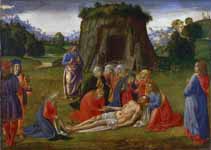Cosimo Rosselli
Paintings
Portrait of a Man
Madonna and Child with the Young Saint John the Baptist

Cosimo Rosselli (1439–1507) was an Italian painter of the Quattrocento, active mainly in his birthplace of Florence.
Born in Florence, at the age of fourteen he became a pupil of Neri di Bicci, and in 1460 he worked as assistant to his cousin Bernardo di Stefano Rosselli. A first youthful work of Cosimo mentioned by Giorgio Vasari is the Assumption of the Virgin altarpiece in the third chapel on the left of the nave in Sant'Ambrogio in Florence. In the same church, on the wall of one of the chapels, is a fresco by Cosimo which Vasari praises highly, especially for a portrait of the young scholar Pico of Mirandola. The scene, a procession bearing a miracle-working chalice, is painted with vigor and less mannerism than most of this artist's work. A picture painted by Rosselli for the church of the Annunziata, with figures of SS. Barbara, Matthew and the Baptist, is in the Academy of Florence.
Rosselli also spent some time in Lucca, where he painted several altar-pieces for various churches. A picture attributed to him, taken from the church of St. Girolamo at Fiesole, is now in the National Gallery of London. It is a large retable, with, in the center, St. Jerome in the wilderness kneeling before a crucifix, and at the sides standing figures of St. Damasus and St. Eusebius, St. Paula and St. Eustochium; below is a predella with small subjects. Though dry and hard in treatment, the figures are designed with much dignity.
In 1480, Rosselli was one of the painters called by Pope Sixtus IV to work at the wall decoration of the Sistine Chapel, together with other masters such as Sandro Botticelli, Pietro Perugino, Domenico Ghirlandaio and others. Rosselli and his collaborators (including his son-in-law Piero di Cosimo) executed two or three frescoes: the Descent from Mount Sinai, the Last Supper and, perhaps, the Sermon of the Mount. The Passage of the Red Sea is variously attributed to him, to Ghirlandaio or to Biagio d'Antonio. Giorgio Vasari wrote in his Lives of the Most Excellent Painters, Sculptors, and Architects that, differently from the other painters who followed a common pattern in the size and style of the frescoes, Rosselli used brighter colors, including gold, a trick which granted him the appreciation of the Pope (who, hints Vasari, appeared to be not a deep expert of art).
The Gemäldegalerie, Berlin has three pictures by Rosselli: The Virgin in Glory, The Entombment of Christ, and The Massacre of the Innocents. In 1480 Rosselli, together with the chief painters of Florence, was invited by Pope Sixtus IV to Rome to assist in the painting of the frescoes in the Sistine Chapel. Three of these were executed by him The Destruction of Pharaohs Army in the Red Sea, Christ Preaching by the Lake of Tiberias, and The Last Supper. His chief pupil was Fra Bartolomeo. Another pupil was Angelo di Donino and Giovanni Battista Vanni.
According to Vasari, Rosselli died in 1484, but this is a mistake, as he was known to have been living on 25 November 1506.
References
Orlandi, Pellegrino Antonio; Guarienti, Pietro (1719), Abecedario pittorico, Naples, p. 61
Orlandi, page 238.
References
Public Domain This article incorporates text from a publication now in the public domain: Chisholm, Hugh, ed. (1911). Encyclopædia Britannica (11th ed.). Cambridge University Press.
Further Reading
Pope-Hennessy, John & Kanter, Laurence B. (1987). The Robert Lehman Collection I, Italian Paintings. New York, Princeton: The Metropolitan Museum of Art in association with Princeton University Press. ISBN 0870994794. (see index; plate 78)
----
Fine Art Prints | Greeting Cards | Phone Cases | Lifestyle | Face Masks | Men's , Women' Apparel | Home Decor | jigsaw puzzles | Notebooks | Tapestries | ...
----
Artist
A - B - C - D - E - F - G - H - I - J - K - L - M -
N - O - P - Q - R - S - T - U - V - W - X - Y - Z
Retrieved from "http://en.wikipedia.org/"
All text is available under the terms of the GNU Free Documentation License






